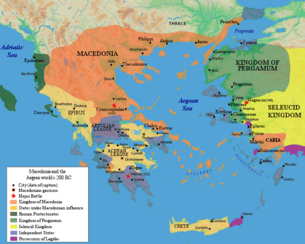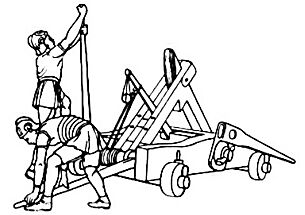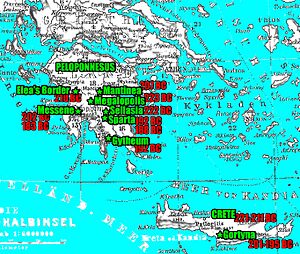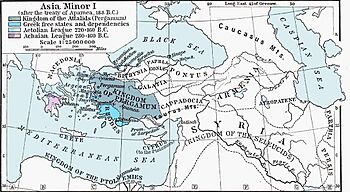War against Nabis facts for kids
Quick facts for kids Laconian War |
|||||||||
|---|---|---|---|---|---|---|---|---|---|
 The Southern Peloponnesus |
|||||||||
|
|||||||||
| Belligerents | |||||||||
| Commanders and leaders | |||||||||
|
|
||||||||
| Strength | |||||||||
| 30,000+ |
|
||||||||
The Laconian War was a conflict in 195 BC. It was fought between the Greek city-state of Sparta and a powerful group of allies. This group included Rome, the Achaean League, Pergamum, Rhodes, and Macedon.
During an earlier war, Sparta had gained control of Argos. Argos was an important city on the coast of Peloponnese. After that war ended, Sparta kept Argos. This made Rome and its allies upset. They used Sparta's control of Argos as a reason to start a new war. The allied forces attacked Argos and captured Sparta's naval base at Gythium. Soon after, they surrounded and attacked Sparta itself. Eventually, both sides agreed to peace. Rome set the terms. Argos and the coastal towns of Laconia were taken from Sparta. Sparta also had to pay money to Rome for eight years. Argos joined the Achaean League, and the Laconian towns were protected by the Achaean League.
Because of this war, Sparta lost its power in Greece. Later attempts by Sparta to get back what it lost failed. Nabis, Sparta's last independent ruler, was killed. Soon after, Sparta was forced to join the Achaean League. This ended hundreds of years of Sparta being an independent and powerful state.
Contents
Why the War Started
After the Spartan leader Machanidas died in 207 BC, Nabis took over. He became king with the help of a mercenary army. Mercenaries are soldiers who fight for money. Sparta's old laws had already changed a lot by then. Nabis's army was made up of many different kinds of people.
In 205 BC, Nabis made a peace deal with Rome. But in 201 BC, he attacked Messene. Messene was an ally of both Sparta and Rome. Sparta had ruled Messene before. The Spartans captured Messene but had to leave when an army led by Philopoemen arrived. Later, Sparta lost a big battle at Tegea. Nabis had to stop his plans to expand Sparta's territory for a while.

During the Second Macedonian War, Nabis saw another chance to expand. Philip of Macedon offered Nabis the city of Argos. In return, Sparta would leave the Roman alliance and join Macedon. Nabis agreed and took control of Argos. But when the war started going badly for Macedon, Nabis switched back to the Roman side. He sent soldiers to help the Roman army. Philip was defeated by the Romans in a big battle. Sparta, however, still controlled Argos. After the war, the Roman army stayed in Greece. They placed soldiers in important locations to protect their interests.
Nabis's Changes
Rome let Nabis keep Argos because he helped them in the war. Nabis made his wife, Apia, the ruler of Argos. Nabis and Apia then took money and land from rich families in both cities. They tortured those who resisted. Much of the land they took was given to freed helots. Helots were enslaved people in Sparta. These freed helots were loyal to Nabis.
After gaining more land and wealth, Nabis began to build up Sparta's navy. He turned the port of Gythium into a major naval base. He also made the city of Sparta stronger with new defenses. His allies from Crete were allowed to use Spartan naval bases. From these bases, they often acted as pirates. Building up the navy gave even poor people a chance to work as rowers. However, this growth in Sparta's naval power worried nearby states and Rome.
Nabis's rule was based on his social changes and rebuilding Sparta's army. Sparta's army used to rely on its full citizens and other free non-citizens. But the number of full Spartan citizens had greatly decreased over time. This made it hard to have a strong army without mercenaries or freed helots. Nabis freed many helots. This was a very important act in Spartan history. By doing this, Nabis removed a main reason why other cities feared Sparta. Before, Sparta always worried about helot revolts. This fear limited Sparta's actions outside its borders. Nabis's action removed this worry. His freed helots received land and married into wealthy families.
Getting Ready for War
The Achaean League was unhappy that Argos, one of its members, was still controlled by Sparta. They convinced the Romans to change their mind about letting Sparta keep Argos. The Romans agreed. They did not want a strong Sparta causing problems after they left Greece.
In 195 BC, the Roman commander in Greece, Titus Quinctius Flamininus, called a meeting. Greek states met at Corinth to decide if they should declare war on Nabis. Most states wanted war. Only the Aetolian League and Thessaly did not. They wanted the Romans to leave Greece. These two states offered to deal with Nabis themselves. But the Achaean League did not want the Aetolian League to become more powerful. Some historians think Rome used this war as an excuse to keep soldiers in Greece. This would stop Sparta and the Aetolian League from joining the Seleucid King Antiochus III if he invaded Greece.
Flamininus first sent a messenger to Sparta. He demanded that Nabis give Argos back to the Achaean League. If not, Nabis would face war with Rome and its allies. Nabis refused. So, 40,000 Roman soldiers and their Greek allies marched towards the Peloponnese. Flamininus joined forces with the Achaean commander, Aristaenos. Together, they had 10,000 foot soldiers and 1,000 horsemen. They then marched towards Argos.
Nabis had put his brother-in-law, Pythagoras, in charge of Argos. Pythagoras had a garrison of 15,000 men. As the Romans and Achaean League approached, a young man from Argos tried to start a revolt. He stood in the city's main square and urged his fellow citizens to rise up. But no large uprising happened. He and most of his followers were killed by the Spartan soldiers.
A few survivors escaped and went to Flamininus's camp. They told him that if he moved his camp closer to the city, the people of Argos would revolt.
The Roman commander sent light infantry and cavalry to find a new camp spot. A small group of Spartan soldiers came out of the city gates. They fought with the Romans about 300 paces from the city walls. The Romans forced the Spartans to retreat back into the city.
Flamininus moved his camp to where the fight had happened. He waited a day for the Spartans to attack, but they did not. He then held a meeting to decide if they should attack the city. All the Greek leaders except Aristaenos wanted to attack Argos. They felt capturing it was their main goal. Aristaenos, however, argued they should go straight to Sparta and Laconia. Flamininus agreed with Aristaenos. The army marched to Tegea. The next day, Flamininus went to Caryae. He waited there for more allied soldiers to join him.
These new forces soon arrived. They included Spartan exiles led by Agesipolis, the true King of Sparta. He had been overthrown years earlier. Also, 1,500 Macedonians and 400 Thessalian horsemen sent by Philip joined them. News also reached the allies that several fleets had arrived off the coast of Laconia. There was a Roman fleet, a Rhodian fleet, and a Pergamene fleet. The Rhodian fleet hoped to stop pirates. The Pergamene fleet hoped to gain favor with Rome.
The War in Laconia
Nabis gathered 10,000 citizens for his army and hired 3,000 more mercenaries. His Cretan allies sent 1,000 special warriors. Nabis feared his people might revolt. So, he ordered the killing of eighty important citizens to scare them. Flamininus left his base and moved towards Sellasia. As the Romans set up camp, Nabis's soldiers attacked them. The surprise attack caused some confusion. But the Spartans retreated when the main Roman army arrived. As the Romans marched past Sparta, Nabis's mercenaries attacked their rear. The Roman commander, Appius Claudius, rallied his troops. He forced the mercenaries to retreat, causing many Spartan losses.
The allied army then went to Amyclae. From there, they raided the nearby countryside. Meanwhile, the Roman naval commander received the surrender of several coastal towns in Laconia. The allies then moved towards Sparta's port and naval base at Gythium. As the land forces began to surround the city, the allied navy arrived. Sailors from the three fleets quickly built siege engines. These machines greatly damaged the city walls. But the Spartan soldiers inside held out bravely.
Eventually, one of the Spartan commanders, Dexagoridas, secretly offered to surrender the city to the Romans. But the other commander, Gorgopas, found out. He killed Dexagoridas himself. Gorgopas continued to fight fiercely. Then Flamininus arrived with 4,000 more soldiers. The Romans attacked again. Gorgopas was forced to surrender. He made sure that he and his soldiers could leave safely and return to Sparta.
Attack on Sparta
During the attack on Gythium, Pythagoras had joined Nabis in Sparta. He brought 3,000 men from Argos. When Nabis learned that Gythium had surrendered, he sent a messenger to Flamininus. Nabis wanted to talk about peace. He offered to remove his soldiers from Argos and hand over any deserters to the Romans. Flamininus held another war council. Most of the council felt they should capture Sparta and remove Nabis from power.
Flamininus replied to Nabis with his own terms. He offered a six-month truce if Nabis would:
- Give Argos back to the Achaean League.
- Give the coastal Laconian cities their freedom and give them his fleet.
- Pay money to Rome over the next eight years.
- Not make alliances with any Cretan cities.
Nabis refused this offer. He claimed he had enough supplies to survive a long attack. So, Flamininus led his army of 50,000 men to Sparta. After defeating the Spartans in a battle outside the city, they began to surround it. Flamininus decided not to have a long siege. Instead, he tried to storm the city walls. The Spartans fought back at first. But the Romans had large shields that made missile attacks useless.
The Romans attacked Sparta and took the walls. Their advance was slow at first because the roads in the city's outer parts were narrow. But as they moved into the city center, the streets became wider. The Spartans were pushed back further and further. Nabis saw his defenses failing and tried to escape. But Pythagoras gathered the soldiers. He ordered them to set fire to buildings near the walls. Burning debris was thrown onto the allied soldiers entering the city. This caused many injuries. Seeing this, Flamininus ordered his forces to pull back. When the attack started again later, the Spartans held off the Romans for three days. Nabis then saw that the situation was hopeless. He sent Pythagoras with an offer to surrender. At first, Flamininus refused to see him. But when Pythagoras came a second time, Flamininus accepted the surrender. The terms of the peace treaty were the same as Flamininus had offered before. The Roman Senate later approved this treaty.
The people of Argos revolted when they heard Sparta was under attack. They attacked the Spartan soldiers there. The Spartan commander surrendered the citadel. He and his men were allowed to leave safely. In return, all Argives serving in Nabis's army could go home.
What Happened Next
After the war, Flamininus visited the Nemean Games in Argos. He announced that Argos was free. The people of Argos immediately decided to rejoin the Achaean League. Flamininus also took all coastal cities of Laconia away from Spartan rule. He placed them under Achaean protection. Sparta's remaining ships were given to these coastal cities. Nabis also had to remove his soldiers from Cretan cities. He had to undo some of his social and economic changes that had made Sparta's army stronger.
However, the Romans did not remove Nabis from the Spartan throne. Even though Sparta was now a small, powerless state without a port, Rome wanted an independent Sparta. This was to balance the growing power of the Achaean League. Nabis showed his loyalty by giving five hostages to Rome, including his son. The Romans did not bring back the Spartan exiles. They wanted to avoid more fighting within Sparta. But they did allow any woman married to a freed helot, whose husband was an exile, to join him.
After the Roman soldiers returned to Italy, the Greek states were on their own again. The main powers were Macedon (which had lost a war to Rome), the Aetolians, the stronger Achaean League, and a much smaller Sparta. The Aetolians had been against Rome's involvement in Greece. They encouraged Nabis to try and get back his old territories and power. By 192 BC, Nabis had built a new fleet and strengthened his army. He attacked Gythium again. The Achaeans asked Rome for help. Rome sent a navy and an embassy led by Flamininus.
The Achaean army and navy, led by Philopoemen, went to Gythium without waiting for the Romans. Nabis's new Spartan fleet defeated the Achaean navy. On land, the Achaeans could not defeat the Spartan forces outside Gythium. Philopoemen retreated. When Philopoemen entered Laconia again, Nabis's forces ambushed him. But Philopoemen still won. The Achaeans then raided Laconia for thirty days without anyone stopping them. The Spartan soldiers stayed inside their fortified city. Plans to capture Sparta itself were being made when Flamininus arrived. He convinced Philopoemen to spare Sparta. For now, Nabis agreed to peace under the same terms as the last treaty.
Since Sparta's army was now weak, Nabis asked the Aetolians for help. They sent 1,000 horsemen to Sparta. The story says that while Nabis was watching his army train, the Aetolian commander attacked and killed him. After Nabis died, the Aetolian soldiers looted the palace and the city. But the Spartans managed to fight back and drive them out. With Sparta in chaos, Philopoemen entered the city with the Achaean army. He made Sparta a member of the Achaean League. Sparta was allowed to keep its laws and territory. But the exiles were not brought back.
In 189 BC, the hostages Rome had taken were allowed to return to Sparta. Nabis's son had died from illness. Sparta still had no port. It also faced problems from hostile exiles nearby. The Spartans captured the city of Las. This city was home to many exiles and part of the Union of Free Laconians. The Achaeans used this as a reason to end Sparta's independence for good. They demanded that those responsible for the attack surrender. The culprits responded by killing thirty pro-Achaean citizens. They then left the Achaean League and asked Rome for protection. The Romans did nothing. They wanted to see division in the League. In 188 BC, Philopoemen entered northern Laconia with an army. He brought the Spartan exiles who wanted to return to Sparta. He first killed eighty anti-Achaeans. Then, he had the wall Nabis built around Sparta torn down. Philopoemen then brought back the exiles. He also ended Spartan law and put Achaean law in its place. This was the end of Sparta's role as a major power in Greece. The Achaean League became the dominant power throughout the Peloponnese.
Images for kids




